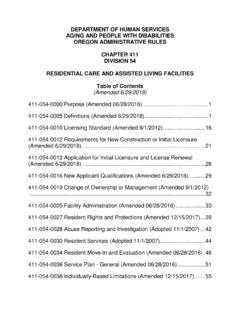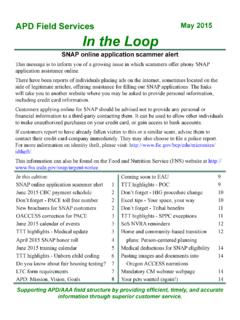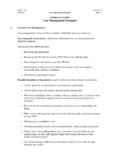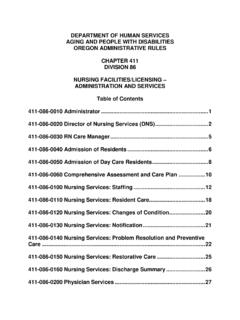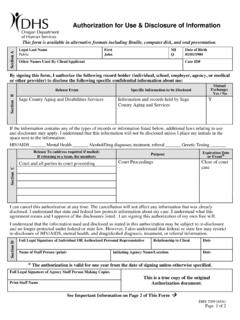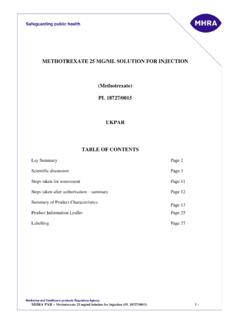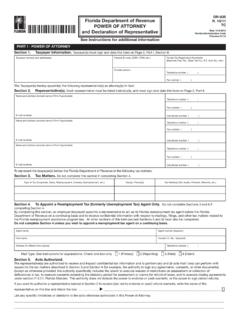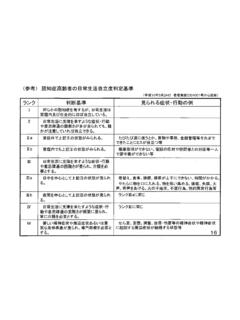Transcription of Long-Term Care Service Priorities for Individuals Served
1 DEPARTMENT OF HUMAN services . AGING AND PEOPLE WITH DISABILITIES. OREGON ADMINISTRATIVE RULES. CHAPTER 411. DIVISION 15. Long-Term care Service Priorities FOR Individuals Served . Table of Contents (Temporary Effective 2/27/2019). 411-015-0000 Purpose (Amended 6/1/2006) .. 1. 411-015-0005 Definitions (Amended 03/29/2018) .. 2. 411-015-0006 Activities of Daily Living (ADL) (Amended 11/18/18) .. 9. 411-015-0007 Instrumental Activities of Daily Living (Adopted 5/1/2006) .. 22. 411-015-0008 Assessments (Amended 11/18/18) .. 25. 411-015-0010 Priority of Paid services (Amended 6/1/2006).. 28. 411-015-0015 Current Limitations (Amended 10/01/2014) .. 30. 411-015-0030 Extended Waiver Eligibility (EWE) (Temporary Effective 2/27/2019 - 8/25/2019).. 32. 411-015-0100 Eligibility for Nursing Facility or Medicaid Home and Community-Based services (Amended 04/03/2015).
2 34. DEPARTMENT OF HUMAN services . AGING AND PEOPLE WITH DISABILITIES. OREGON ADMINISTRATIVE RULES. CHAPTER 411. DIVISION 15. Long-Term care Service Priorities FOR Individuals Served . 411-015-0000 Purpose (Amended 6/1/2006). The purpose of establishing Priorities for persons to be Served is to assist the Department in addressing the following goals: (1) To enable persons eligible for and receiving services to remain in the least restrictive and least costly setting consistent with their Service needs;. and (2) To serve those persons who are the most functionally impaired and who have no or inadequate alternative Service resources; and (3) To assure access to services paid by the Department to eligible persons; and (4) To assure that services paid by the Department, and the setting in which they are provided are safe and adequate; and (5) To manage limited resources to enable the greatest possible number of persons to receive needed services through a priority system based on the Department's assessment of the individual's functional impairment and alternative Service resources.
3 Stat. Auth.: ORS Stats. Implemented: ORS Page 1. 411-015-0005 Definitions (Amended 03/29/2018). Unless the context indicates otherwise, the following definitions apply to the rules in OAR chapter 411, division 015: (1) "AAA" means "Area Agency on Aging" as defined in this rule. (2) "Activities of Daily Living (ADL)" mean those personal functional activities required by an individual for continued well-being, which are essential for health and safety. Activities include eating, dressing and grooming, bathing and personal hygiene, mobility, elimination, and cognition. (3) "Adult" means any person at least 18 years of age. (4) "Alternative Service Resources" means other possible resources for the provision of services to meet an individual's needs.
4 Alternative Service resources include, but are not limited to, natural supports, risk intervention services , Older Americans Act programs, or other community supports. Alternative Service resources are not paid by Medicaid. (5) "Architectural Modifications" means any Service leading to the alteration of the structure of a dwelling to meet the specific Service needs of an eligible individual. (6) "Area Agency on Aging (AAA)" means the Department designated agency charged with the responsibility to provide a comprehensive and coordinated system of services to older adults and adults with disabilities in a planning and Service area. The term Area Agency on Aging (AAA) is inclusive of both Type A and Type B AAAs as defined in ORS to (7) "Assistance Types" needed for activities of daily living and instrumental activities of daily living include the following: (a) "Cueing" means giving verbal or visual clues during an activity to help an individual complete the activity without hands-on assistance.
5 Page 2. (b) "Hands-on" means a provider physically performs all or parts of an activity because an individual is unable to do so. (c) "Monitoring" means a provider must observe an individual to determine if intervention is needed. (d) "Reassurance" means to offer an individual encouragement and support. (e) "Redirection" means to divert an individual to another more appropriate activity. (f) "Set-up" means getting personal effects, supplies, or equipment ready so that an individual may perform an activity. (g) "Stand-by" means a provider is at the side of an individual ready to step in and take over the task if the individual is unable to complete the task independently. (h) "Support" means to enhance the environment to enable an individual to be as independent as possible.
6 (8) "Assistive Devices" means any category of durable medical equipment, mechanical apparatus, electrical appliance, instrument of technology, Service animal, general household items, or furniture used to assist and enhance an individual's independence in performing any activity of daily living. (9) "Behavioral care Plan" means a documented set of procedures, reviewed by the Department or AAA representative, which describes interventions for use by a provider to prevent, mitigate, or respond to behavioral symptoms that negatively impact the health and safety of an individual or others in a home or community-based services setting. The preferences of an individual are included in developing a Behavioral care Plan. Page 3. (10) "Business Days and Hours" means Monday through Friday and excludes Saturdays, Sundays, and state or federal holidays.
7 Hours are from 8:00 AM to 5:00 PM. (11) "CA/PS" means "Client Assessment and Planning System" as defined in this rule. (12) " care Setting" means a Medicaid contracted facility where a Medicaid eligible individual resides and receives services . care settings include adult foster homes, residential care facilities, assisted living facilities, specialized living contracted residences, and nursing facilities. (13) "Case Manager" means an employee of the Department or AAA who assesses the Service needs of Individuals , determines eligibility, and offers Service choices to eligible Individuals . The case manager authorizes and implements an individual's Service plan and monitors the services delivered as described in OAR chapter 411, division 028. (14) "Client Assessment and Planning System (CA/PS)" means: (a) The single entry data system used for - (A) Completing a comprehensive and holistic assessment.
8 (B) Surveying an individual's physical, mental, and social functioning; and (C) Identifying risk factors, individual choices and preferences, and the status of Service needs. (b) The CA/PS documents the level of need and calculates the individual's Service priority level in accordance with these rules, calculates the Service payment rates, and accommodates individual participation in Service planning. (15) "Cognition" means the individual's mental functional ability to ensure their health, safety and basic needs are met. It includes the individual's Page 4. understanding of the need to perform and manage ADLs and IADLS. It does not refer to choices an individual may make that others may deem to be unsafe. Nor does it refer to an individual's knowledge and skills, rather their cognitive ability to use and process information.
9 (16) "Component" means distinct parts of an ADL or IADL that are defined within each ADL or IADL. (17) "Cost Effective" means being responsible and accountable with Department resources. This is accomplished by offering less costly alternatives when providing choices that adequately meet an individual's Service needs. Those choices consist of all available services under the Medicaid home and community-based Service options, the utilization of assistive devices, natural supports, architectural modifications, and alternative Service resources not paid for by the Department. (18) "Department" means the Department of Human services (DHS). (19) "Disability" means a physical, cognitive, or emotional impairment which, for an individual, constitutes or results in a functional limitation in one or more of the activities of daily living defined in OAR 411-015-0006.
10 (20) "Event Specific" means situations that are not part of the individual's daily or weekly routine, such as doctor visits or other outings. (21) "Extraordinary Circumstances" means: (a) An individual being assessed is working full time during business hours; or (b) A family member, whose presence is requested by an individual being assessed, is traveling from outside the area, and is available for only a limited period of time that does not include business days and hours. (22) "Extended Waiver Eligibility (EWE)" means the criteria that allows Individuals assessed at Service Priority Level 14-17, who are determined to Page 5. have a high risk for hospitalization or institutionalization within 30 days of Medicaid Long Term services and Supports ending to continue receiving Medicaid Long Term services and Supports until the risks can be mitigated.

